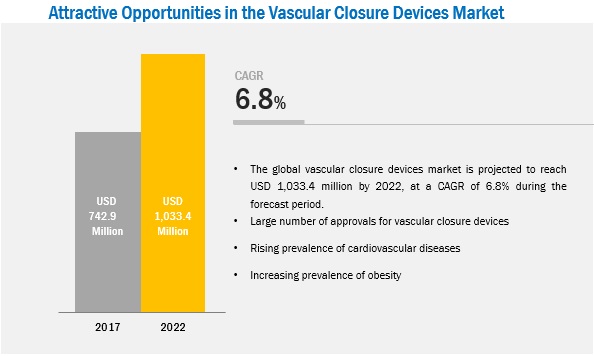The global vascular closure devices market is expected to reach USD 984.6 Million by 2022 from USD 704.8 Million in 2017, at a CAGR of 6.9%.
The increasing interventional procedures using radial access, the high cost of vascular closure devices, and the risks associated with vascular closure devices are the major restraints for the market
Vascular closure devices are relatively high-priced devices compared to manual compression devices. The average price of a vascular closure device is about USD 150–USD 250 while that of a manual compression device is about USD 15–USD 25. The cost of VCDs essentially adds up to the patient’s hospitalization bill and even increases the per patient cost for hospitals and simultaneously reduces profits.
Moreover, radial artery access makes it more convenient for doctors to achieve hemostasis using simple manual compression methods. Interventional procedures using radial artery access do not generally require vascular closure devices, which is another factor that leads to cost savings.
Additionally, malfunctioning of devices, poor quality, and underperformance of devices are the primary causes of product recalls. Product failures and recalls cost companies millions of dollars in product replacements and lost revenues. They may also create a negative impression about the product, which in turn may limit the adoption of these products.
However, growth in target markets in emerging nations such as China, India, and Brazil, offer significant growth opportunities for players operating in the vascular closure devices market.
Download PDF Brochure @
https://www.marketsandmarkets.com/pdfdownloadNew.asp?id=180101468
https://www.marketsandmarkets.com/pdfdownloadNew.asp?id=180101468
The benefits of interventional cardiology procedures including reduced scarring and less pain due to their minimally invasive nature are driving the interventional cardiology market from vascular closure devices.
Interventional cardiologists use vascular closure devices to close the artery after the procedure. Interventional cardiology deals specifically with catheter-based treatment of structural heart diseases. These procedures are done through blood vessels like the transfemoral or transradial artery for angioplasty and stenting. Market players offer on-hand practice to surgeons, physicians, and cardiologists for their vascular closure devices. This ensures safety, efficiency, and the effective deployment of these devices during cardiac procedures.
CVDs are the leading cause of death worldwide. This figure for deaths caused due to CVDs is expected to increase to 23.6 million by 2030 (Source: World Health Organization). The significant growth in the incidence of CVDs is resulting in an increase in the demand for cardiac interventional procedures.
Inquiry about Vascular Closure Devices Market @ https://www.marketsandmarkets.com/Enquiry_Before_BuyingNew.asp?id=180101468



